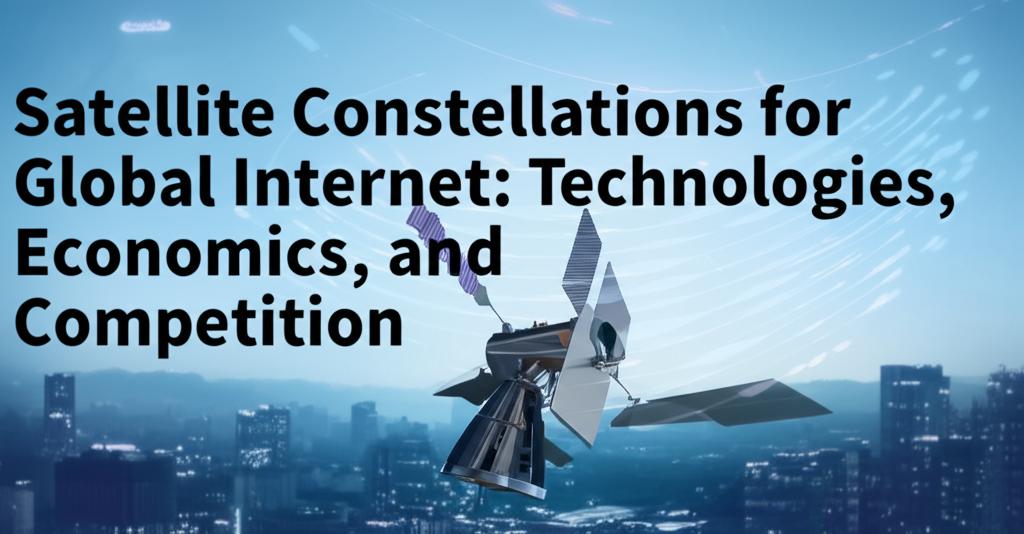The landscape of global internet connectivity is rapidly transforming, largely driven by the deployment of vast satellite constellations operating primarily in Low Earth Orbit (LEO). These networks aim to provide high-speed, low-latency broadband access to virtually any point on the globe, promising to bridge the digital divide and enable a new era of connected services.
Core Technologies Driving Satellite InternetModern satellite internet relies heavily on LEO constellations. Unlike traditional geostationary (GEO) satellites orbiting ~36,000 km away, LEO satellites operate much closer to Earth, typically between 160 km and 2,000 km altitude. This proximity significantly reduces signal travel time (latency), making LEO internet suitable for real-time applications like video conferencing, online gaming, and cloud computing.
Key technological components include:
- Large Constellations: LEO systems require hundreds or thousands of satellites working in concert to ensure continuous global coverage, as each satellite moves rapidly across the sky.
- Advanced Satellite Design: Satellites are becoming smaller, lighter, and more efficient, often mass-produced to reduce costs. They incorporate sophisticated technologies like phased array antennas for flexible beam steering and inter-satellite links (often using lasers) to route traffic efficiently through space, reducing reliance on ground stations.
- Ground Infrastructure: A network of gateway earth stations connects the satellite constellation to the terrestrial internet backbone.
- User Terminals: Sophisticated but increasingly user-friendly terminals (dishes and modems) automatically track satellites passing overhead to maintain connection. Efforts are underway to make these cheaper and more accessible.
- Frequency Bands: K-band (Ku and Ka) frequencies are widely used, offering higher data transfer rates and bandwidth crucial for broadband services.
- AI Integration: Artificial intelligence is increasingly used for network optimisation, traffic management, collision avoidance, and enhancing satellite performance.
The satellite internet market is experiencing explosive growth. Estimates project the market value to rise significantly in the coming years. For instance, one report valued the market at $4.0 billion in 2023, projecting it to reach $17.1 billion by 2028 (33.7% CAGR). Another analysis estimated $5.1 billion in 2024, reaching $24.6 billion by 2030 (29.9% CAGR). A different forecast projects growth from $8.09 billion in 2025 to $25.67 billion by 2032 (17.9% CAGR). While specific figures vary, the trend is clear: rapid expansion driven by strong demand.
Key economic drivers include:
- Bridging the Digital Divide: Providing high-speed internet to remote, rural, and underserved regions lacking terrestrial infrastructure is a primary driver.
- Sector-Specific Demand: Growing adoption in maritime, aviation, energy, mining, agriculture, government, and military sectors boosts the market.
- Emerging Technologies: Supporting IoT, 5G/6G integration, autonomous vehicles, and edge computing applications fuels demand.
- Resilience and Backup: LEO internet offers a viable backup/redundancy solution for businesses and critical infrastructure.
Despite the potential, significant economic challenges remain:
- High Initial Costs: Designing, manufacturing, and launching thousands of satellites represents a massive upfront investment.
- Capacity Limitations: While total constellation capacity is large, the practical bandwidth available per user can become limited as subscriber density increases in a satellite's coverage area. Studies suggest mega-constellations may need to operate at low user densities to deliver speeds competitive with terrestrial options.
- Environmental Costs & Sustainability: Concerns are rising about space debris, orbital congestion, and the carbon footprint of frequent launches. Full satellite demisability upon re-entry is becoming a design requirement.
The satellite internet market is rapidly becoming a competitive arena involving major technology companies and national initiatives:
- Starlink (SpaceX): The current market leader, having deployed thousands of satellites (over 6,750 as of early 2025) and serving millions of customers globally. Starlink benefits from SpaceX's reusable launch capabilities, enabling rapid deployment and updates. It adopts a vertically integrated model, controlling the network, hardware, and customer service directly.
- OneWeb (Eutelsat Group): Operates a constellation of over 600 satellites, primarily targeting enterprise, government, maritime, and aviation markets, often through value-added resellers (VARs) like Gogo and Satcom Direct. It faced financial difficulties but is now part of Eutelsat Group.
- Project Kuiper (Amazon): A major contender planning a constellation of over 3,200 satellites, with ambitious deployment goals (half by mid-2026). Amazon is investing heavily ($10 billion+) and plans to leverage its resources for global reach, aiming for affordable user terminals.
- National/Regional Constellations:
China: Actively developing multiple constellations, including the state-owned GuoWang and the G60/Qianfan project aiming for potentially tens of thousands of satellites. This reflects a strategic push for independent space-based infrastructure.
European Union (IRIS²): Planning a secure connectivity constellation of around 290 satellites in multiple orbits by 2027.
Telesat (Canada): Developing its Lightspeed constellation, focusing on enterprise and government markets.
Others: Various other players and national initiatives exist, like Russia's Sfera project.
Competition is fierce, driving innovation in technology, pricing models, and service offerings. Different players employ varying strategies, from direct-to-consumer models (Starlink) to wholesale/partner-focused approaches (OneWeb).
Future Trends and OutlookThe satellite internet sector continues to evolve rapidly:
- Next-Generation Orbits: Exploration of Very Low Earth Orbit (VLEO, below 400 km) could offer even lower latency but faces challenges like atmospheric drag and regulatory hurdles.
- Direct-to-Device Connectivity: Enabling standard smartphones to connect directly to satellites for basic messaging, voice, and data services is a major emerging trend, with players like Starlink, Lynk Global, AST SpaceMobile, and others actively developing solutions.
- Integration with 5G/6G: Satellite networks are increasingly seen as integral components of future terrestrial networks (Non-Terrestrial Networks or NTN), providing backhaul and extending coverage for 5G and upcoming 6G standards.
- Enhanced Capabilities: Expect larger constellations, faster speeds, lower latency through improved inter-satellite links and ground systems, smaller/more efficient terminals, and increased use of AI for network management.
- Sustainability Focus: Addressing space debris, responsible deorbiting, and the environmental impact of launches will become increasingly critical.
Satellite constellations are fundamentally reshaping global communications. While challenges related to cost, capacity, and sustainability persist, the drive to connect the unconnected and power next-generation applications ensures this technology will remain a critical and dynamic part of the digital infrastructure for the foreseeable future.

